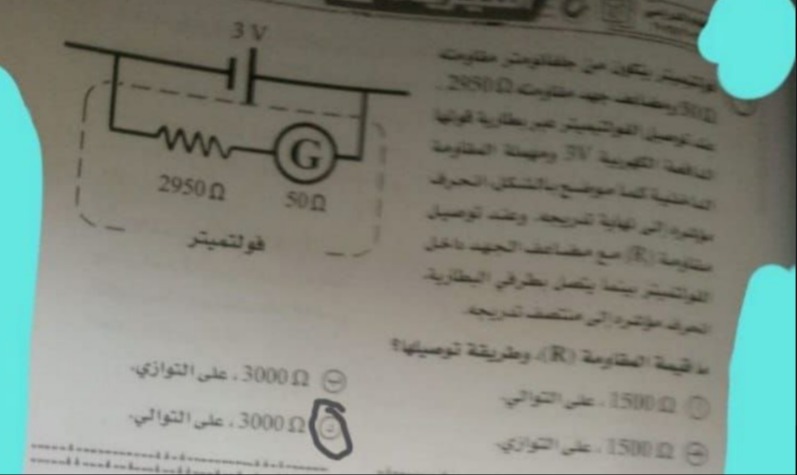Question
Question: عند توصيل الفولتميتر عبر بطارية قوتها الدافعة الكهربية 30 ومهملة المقاومة الداخلية كما موضح بالشكل ا...
عند توصيل الفولتميتر عبر بطارية قوتها الدافعة الكهربية 30 ومهملة المقاومة الداخلية كما موضح بالشكل الحرف مؤشرة إلى نهاية تدريجه وعند توصيل مقاومة (R) مع مضاعف الجهد داخل الفواتيميتر بينما يتصل بطرفي البطارية الحرف مؤشرة إلى منتصف تدريجه
ما قيمة المقاومة (R) وطريقة توصيلها ؟

3000 Ω ، على التوازي.
3000 Ω ، على التوالي.
1500 Ω ، على التوالي.
1500 Ω ، على التوازي.
3000 Ω ، على التوالي.
Solution
The problem describes a voltmeter constructed from a galvanometer and a series multiplier resistance. We need to determine the value and connection method of an additional resistance (R) added to the multiplier part, given the change in deflection.
Step 1: Calculate the full-scale deflection current (IG) of the galvanometer.
Initially, the voltmeter consists of a galvanometer with resistance RG=50Ω connected in series with a multiplier resistance RM=2950Ω. The total resistance of the voltmeter (RV) is: RV=RG+RM=50Ω+2950Ω=3000Ω
When this voltmeter is connected across a battery with EMF V=3V, the pointer deflects to the end of its scale. This means 3V is the full-scale voltage (Vmax) and the current flowing through the galvanometer is the full-scale deflection current (IG). Using Ohm's Law: Vmax=IG×RV 3V=IG×3000Ω IG=3000Ω3V=0.001A=1mA
Step 2: Determine the new total resistance of the voltmeter when R is added.
When the resistance (R) is added, the voltmeter is still connected to the 3V battery, but the pointer deflects to the middle of its scale. This means the current flowing through the galvanometer is half of the full-scale deflection current: I′=2IG=21mA=0.5mA=0.0005A
Let the new total resistance of the voltmeter be RV′. Using Ohm's Law for this new configuration: V=I′×RV′ 3V=0.0005A×RV′ RV′=0.0005A3V=6000Ω
Step 3: Determine the value and connection of R.
The galvanometer resistance RG=50Ω remains unchanged and is always in series with the effective multiplier resistance. The new total resistance of the voltmeter is RV′=RG+RM,eff′, where RM,eff′ is the effective resistance of the multiplier part after adding R. 6000Ω=50Ω+RM,eff′ RM,eff′=6000Ω−50Ω=5950Ω
The original multiplier resistance was RM=2950Ω. We need to connect R with RM to get an effective resistance of RM,eff′=5950Ω.
-
If R is connected in parallel with RM: The equivalent resistance of two resistors in parallel is always less than the smallest individual resistance. Since RM=2950Ω, a parallel combination with R would result in RM,eff′<2950Ω. However, we calculated RM,eff′=5950Ω. Therefore, R cannot be connected in parallel with RM.
-
If R is connected in series with RM: The equivalent resistance of two resistors in series is their sum. RM,eff′=RM+R 5950Ω=2950Ω+R R=5950Ω−2950Ω=3000Ω
This result is consistent with the requirement. Thus, the resistance R is 3000Ω and it is connected in series with the multiplier resistance.
